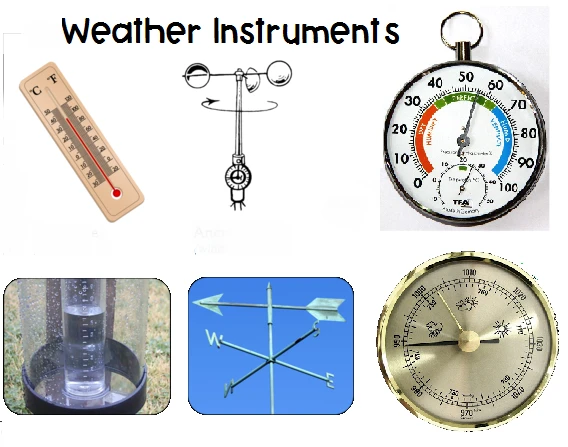
# The Instruments of the Weather
## Understanding Weather Instruments
Weather instruments are essential tools used by meteorologists and weather enthusiasts to measure and predict atmospheric conditions. These devices help us understand the complex dynamics of the weather, enabling accurate forecasts and climate studies.
### The Most Common Weather Instruments
Let’s explore some of the fundamental instruments used in weather observation:
#### 1. Thermometer
The thermometer is perhaps the most recognizable weather instrument. It measures air temperature, typically using mercury or alcohol in a glass tube that expands or contracts with temperature changes.
#### 2. Barometer
This instrument measures atmospheric pressure, which is crucial for predicting weather changes. A falling barometer often indicates approaching storms, while rising pressure suggests fair weather.
#### 3. Hygrometer
Hygrometers measure humidity – the amount of water vapor in the air. This information is vital for understanding precipitation potential and human comfort levels.
#### 4. Anemometer
Anemometers measure wind speed, helping meteorologists track storm intensity and predict weather patterns. The most common type uses rotating cups that spin faster with stronger winds.
#### 5. Rain Gauge
This simple but important instrument measures precipitation amounts. Modern versions can automatically record rainfall data over time.
## Advanced Weather Measurement Tools
Beyond the basic instruments, meteorologists use more sophisticated equipment:
### Weather Balloons
These carry instrument packages called radiosondes high into the atmosphere, measuring temperature, humidity, pressure, and wind at various altitudes.
### Weather Satellites
Orbiting satellites provide global coverage of weather patterns, cloud formations, and storm development, offering invaluable data for forecasting.
### Doppler Radar
This advanced radar system can detect precipitation intensity and movement, helping to predict severe weather events like tornadoes.
## The Importance of Weather Instruments
Accurate weather data collected by these instruments serves multiple purposes:
Weather forecasting saves lives by providing advance warning of severe storms. Farmers rely on weather data for planting and harvesting decisions. Aviation depends on precise weather information for flight safety. Climate scientists use long-term weather instrument data to study climate change patterns.
## Maintaining Weather Instruments
For accurate measurements, proper maintenance is crucial:
Instruments should be regularly calibrated and placed in appropriate locations. Thermometers, for example, should be shielded from direct sunlight while allowing air circulation. Rain gauges must be positioned away from obstructions that might block precipitation.
## The Future of Weather Instruments
Technological advancements continue to improve weather measurement:
Smart weather stations now connect to the internet, providing real-time data. Miniaturized sensors allow for more detailed atmospheric measurements. Artificial intelligence helps process vast amounts of weather data for more accurate predictions.
Understanding these instruments helps us appreciate the science behind weather forecasting and our ability to prepare for atmospheric changes. Whether you’re a professional meteorologist or simply curious about the weather, knowing how these tools work enhances your understanding of our dynamic atmosphere.
Keyword: instruments of the weather
